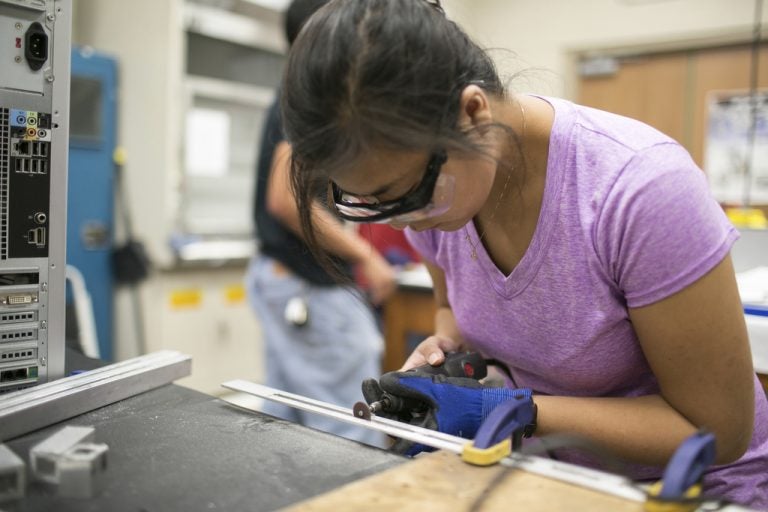Next week, a team of UCF students will head to NASA’s Kennedy Space Center with a robot they’ve been building since last summer – one that’s designed to mine soil and ice from the surface of Mars.
Their robot isn’t destined for the red planet, but elements of its design might be. It will compete in the 6th Annual NASA Robotic Mining Competition, a contest meant to help NASA find innovative ideas for its own robotic landers as it looks ahead to manned missions to Mars.
The UCF robot, built by a team of mostly women with a mix of high-tech components and off-the-shelf parts you might find at Home Depot, will compete against 48 other teams from universities across the country. It uses an auger from a posthole digger, is powered by a motorcycle battery and guided by a modified Xbox controller.
“My real passion is space exploration. It’s what I breathe, what I eat, what I love,” said Kelly Lai, the recent aerospace engineering graduate who leads the effort. “To produce something and present it to NASA engineers who could say, ‘That’s a great idea, we’re going to put it on the robot and put it in space,’ that to me is exactly what I live for.”
If a manned mission to Mars is to be successful, astronauts will have to take advantage of the planet’s resources, including ice buried beneath the surface that would be an important source of water. Entrants in the NASA competition are essentially mining-bots that should be capable of traversing a pit filled with simulated Martian soil, excavating and collecting both the surface soil and the simulated ice underneath, and depositing it at a collection point.
There are challenges, including obstacles and craters to avoid. Perhaps the biggest is the soil itself, known as regolith. It’s volcanic ash the consistency of flour, so fine that it can infiltrate the robot’s systems, damaging motors and wreaking havoc with electronics.
UCF’s robot is expected to differ from most others. Instead of the scoops and bucket systems that are more typical at the competition, the Knights’ robot will use a corkscrew-like auger. The bot is named Xkadrill, after a Pokémon character whose arms are tipped with drills.
Lai hopes the project brings vindication. She was part of a smaller, five-person team at the competition last year, but the lander they’d spent so much time building was dropped a few minutes before start time, causing severe damage and forcing the team to withdraw.
“I was so upset,” Lai said. “It was the first time UCF was represented at the competition, and I didn’t want to let UCF down. Failing was so heartbreaking.”
She learned her lesson. The new team is an interdisciplinary one with a wide range of built-in expertise. It’s structured like a business, with 35 members representing seven different majors, from engineering and computer science to accounting, marketing and even psychology.
“She said, ‘I want to structure it like an industry,’” said Thais Lage, an aerospace engineering major and the team’s vice president. “Because nowhere when you graduate are you only going to work with aeros or only going to work with mechanicals.”
Though it wasn’t planned, the majority of the team’s members are women, including Lai, who is president, and the other three executive board members. Lai and Lage began brainstorming ideas for a new robot via video conference last summer, and started recruiting members at the start of the fall semester.
They formed a registered student organization, the Lunar Knights Mining Club, to obtain funding from the Student Government Association to help pay for the project. Under the guidance of faculty advisors Justin Karl and Adrienne Dove, team members have designed and built the robot, and along the way taught themselves to weld and machine parts.
The competition runs from May 18-22, with practice time the first two days. Winners in various categories will be awarded team scholarships, trophies and invitations to launches at Kennedy Space Center.
